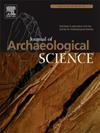从保存较差的骨骼遗骸中重建生活史和祖先:意大利法恩扎铜时代婴儿的生物人类学研究
IF 2.5
1区 地球科学
Q1 ANTHROPOLOGY
引用次数: 0
摘要
考古遗骨,特别是婴儿遗骨的保存不佳,可能导致人口的部分代表,并严重限制了我们对其婴儿部分的发育和生活的理解。本研究探讨了结合牙齿组织学、高空间分辨率生物地球化学、放射性碳测年、古蛋白质组学和古DNA (aDNA)分析以及传统的骨学方法来重建意大利法恩扎一具严重降解的婴儿骨骼遗骸的生物学特征和生活史的潜力。严重的骨骼退化只留下牙冠和小骨碎片,限制了传统的骨学分析对死亡年龄的估计。对两个牙齿标本(一颗乳牙右上第一磨牙和一颗永久右下第一磨牙)的组织学分析提供了对婴儿发育的详细了解,最终确定了死亡年龄约为17个月。利用激光烧蚀-电感耦合等离子体质谱(LA-ICPMS)进行生物地球化学分析,发现明显的成岩改变掩盖了原始的生物成因信号。牙釉质肽的蛋白质组学分析和骨骼碎片的基因组学分析确定了婴儿的性别为男性。基因组分析,在足够数量的内源性aDNA的帮助下,使线粒体基因组的重建成为可能,为个体的母系祖先提供了有价值的见解,并确定了意大利半岛新石器时代一个不常见的mtDNA单倍群。尽管骨骼元素的保存有限,但先进生物人类学技术的结合应用表明,即使是少数保存的解剖元素也具有巨大的信息潜力。这项研究强调了多学科方法在克服高度退化遗骸带来的挑战方面的关键价值,揭示了否则无法获得的见解。本文章由计算机程序翻译,如有差异,请以英文原文为准。
Reconstructing life history and ancestry from poorly preserved skeletal remains: A bioanthropological study of a Copper Age infant from Faenza (RA, Italy)
The poor preservation of archaeological skeletal remains, particularly those of infants, can result in partial representations of populations and significantly limit our understanding of the development and life of their infant segment. This study investigates the potential of combining dental histology, high spatial resolution biogeochemistry, radiocarbon dating, palaeoproteomic and ancient DNA (aDNA) analyses alongside traditional osteological methods to reconstruct the biological profile and life history of the heavily degraded skeletal remains of an infant from Faenza, Italy.
Severe skeletal degradation left only dental crowns and small osseous fragments, restricting traditional osteological analysis to an estimation of the age at death. Histological analysis of two dental specimens, a deciduous upper right first molar and a permanent lower right first molar, provided detailed insights into the infant's development, ultimately refining the age at death at approximately 17 months. Biogeochemical analysis using Laser Ablation-Inductively Coupled Plasma Mass Spectrometry (LA-ICPMS) revealed pronounced diagenetic alterations masking the original biogenic signal. Proteomic analysis of enamel peptides and genomic analysis of the osseous fragments identified the infant's sex as male. Genomic analysis, facilitated by a sufficient quantity of endogenous aDNA, enabled the reconstruction of the mitochondrial genome, providing valuable insights into the matrilineal ancestry of the individual and identifying an uncommon mtDNA haplogroup for the Eneolithic period in the Italian peninsula.
Despite the limited preservation of the skeletal elements, the combined application of advanced bioanthropological techniques demonstrated the substantial informative potential inherent in even a few preserved anatomical elements. This study underscores the critical value of multidisciplinary approaches in overcoming the challenges posed by highly degraded remains, revealing insights that would otherwise remain inaccessible.
求助全文
通过发布文献求助,成功后即可免费获取论文全文。
去求助
来源期刊

Journal of Archaeological Science
地学-地球科学综合
CiteScore
6.10
自引率
7.10%
发文量
112
审稿时长
49 days
期刊介绍:
The Journal of Archaeological Science is aimed at archaeologists and scientists with particular interests in advancing the development and application of scientific techniques and methodologies to all areas of archaeology. This established monthly journal publishes focus articles, original research papers and major review articles, of wide archaeological significance. The journal provides an international forum for archaeologists and scientists from widely different scientific backgrounds who share a common interest in developing and applying scientific methods to inform major debates through improving the quality and reliability of scientific information derived from archaeological research.
 求助内容:
求助内容: 应助结果提醒方式:
应助结果提醒方式:


